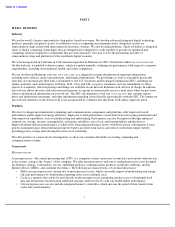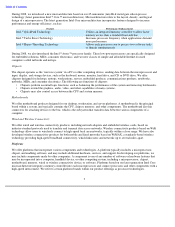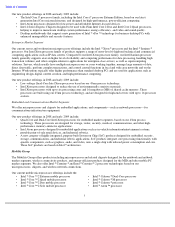Intel 2008 Annual Report Download - page 16
Download and view the complete annual report
Please find page 16 of the 2008 Intel annual report below. You can navigate through the pages in the report by either clicking on the pages listed below, or by using the keyword search tool below to find specific information within the annual report.
Table of Contents
Our products compete primarily based on performance, features, price, quality, reliability, brand recognition, and availability.
We are focused on offering innovative products and worldwide support for our customers at competitive prices, including
providing improved energy-efficient performance, enhanced security, manageability, and integrated solutions. We believe that
our platform strategy provides us with a competitive advantage. We offer platforms that incorporate various components
designed and configured to work together to provide an optimized user computing solution compared to components that are
used separately.
Our competitors range in size from large established multinational companies with multiple product lines to smaller
companies and new entrants to the marketplace that compete in specialized market segments. Some of our competitors may
have development agreements with other companies, and in some cases our competitors may also be our customers or
suppliers. Product offerings may cross over into multiple product categories, providing us with new opportunities but also
resulting in more competition. It may be difficult for us to compete in market segments in which our competitors have
established products and brand recognition.
We believe that our network of manufacturing facilities and assembly and test facilities gives us a competitive advantage. This
network enables us to have more direct control over our processes, quality control, product cost, volume, timing of production,
and other factors. These facilities require significant up-front capital spending, and many of our competitors do not own such
facilities because they may not be able to afford to do so or because their business models involve the use of third-party
facilities for manufacturing and assembly and test. These “fabless semiconductor companies” include Broadcom Corporation,
NVIDIA Corporation, QUALCOMM Incorporated, and VIA Technologies, Inc. (VIA). Some of our competitors own portions
of such facilities through investment or joint-venture arrangements with other companies. Advanced Micro Devices, Inc.
(AMD) intends to sell an interest in its manufacturing operations.
A group of foundries and assembly and test subcontractors offers their services to companies that do not own facilities or to
companies needing additional capacity. These foundries and subcontractors may also offer intellectual property, design
services, and other goods and services to our competitors. A disadvantage of our approach compared to fabless semiconductor
companies is that it is more difficult for us to reduce our costs in the short term. Also, competitors who outsource their
manufacturing and assembly and test operations can significantly reduce their capital expenditures.
We plan to continue to cultivate new businesses and work with the computing and communications industries through
standards bodies, trade associations, OEMs, ODMs, and independent software and operating system vendors to help align the
industry to offer products that take advantage of the latest market trends and usage models. We frequently participate in
industry initiatives designed to discuss and agree upon technical specifications and other aspects of technologies that could be
adopted as standards by standards-setting organizations. Our competitors may also participate in the same initiatives and
specification development. Our participation does not ensure that any standards or specifications adopted by these
organizations will be consistent with our product planning.
Microprocessors
We continue to be largely dependent on the success of our microprocessor business. Our ability to compete depends on our
ability to deliver new microprocessor products with improved overall performance and improved energy-
efficient performance
at competitive prices. Some of our microprocessor competitors, such as AMD, market software-compatible products that
compete with our processors. We also face competition from companies offering rival architecture designs, such as Cell
Broadband Engine Architecture developed jointly by International Business Machines Corporation (IBM), Sony Corporation,
and Toshiba Corporation; Power Architecture* offered by IBM; ARM architecture developed by ARM Limited; and Scalable
Processor Architecture (SPARC*) offered by Sun Microsystems, Inc. NVIDIA has developed a programming interface to
attempt to expand the use of its graphics processors to accomplish general-purpose computing functions typically performed
by a microprocessor in highly parallel applications.
The following is a list of our main microprocessor competitors by market segment:
In addition, our Intel Atom processor family competes against processors offered by AMD and VIA, and from companies
using rival architectures, such as ARM and MIPS.
11
•
Desktop: AMD and VIA
•
Mobile: AMD and VIA
•
Enterprise: AMD, IBM, and Sun Microsystems
•
Embedded: AMD, Freescale Semiconductor, Inc., and VIA
























